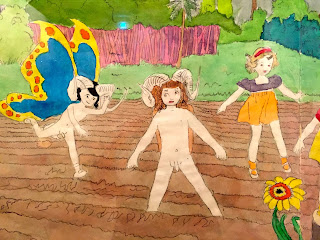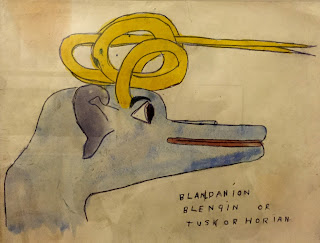ART BRUT CAN BE REALLY VIOLENT
Anne texted me not so long ago saying that she was a the "Henry Darger exhibition". I couldn’t for the life of me work out why the name rang such a strong bell. I certainly didn’t know the artist - or didn’t think I did. I discovered that he was on my exhibition list which I complete once a month with updates from the many art reviews I receive. I could add here that there is very little I was to see at the moment, which is a bit frustrating.
Henry Darger (1892-1973)had what I suppose could be described as a rather sad life. His Mother died when he was a very young boy. Although his father was a kind man, when he died too, Henry was sent to an asylum as he was thought to be a simpleton. Later he escaped and came back to Chicago where he was born and and lived off small incomes which came from odd jobs in hospitals. As with so many of these artists, his work was discovered after he died. In actual fact it was a photographer who discovered his work. In secret, he had written a novel of 15 000 pages: « The Story of the Vivian Girls in the Realms of the Unreal ». The story is actually known as the «Realms of the Unreal » It follows the adventures
of the daughters of Robert Vivian, seven princesses of the Christian nation of Abbieannia who assist a daring rebellion against the evil regime of child slavery imposed by John Manley and the Glandelinians. Children take up arms in their own defense and are often slain in battle or viciously tortured by the Glandelinian overlords. The elaborate mythology includes the setting of a large planet, around which Earth orbits as a moon (where most people are Christian and mostly Catholic), and a species called the "Blengigomeneans" (or Blengins for short), gigantic winged beings with curved horns who occasionally take human or part-human form, even disguising themselves as children. They are usually benevolent, but some Blengins are extremely suspicious of all humans, due to Glandelinian atrocities. Darger illustrated his stories using a technique of traced images cut from magazines and catalogues, arranged in large panoramic landscapes and painted in watercolours, some as large as 30 feet wide and painted on both sides.
He wrote himself into the narrative as the children's protector. What of course strikes you immediately is that all the little girls have penises. There is no explanation given to this in the exhibition but something I looked up at once. His iconography is unmistakable but baffling: Hermaphroditic children; children with rams' horns and butterfly wings; children stalked, strangled, or slaughtered; runaway flora and fauna; tornadoes.
 |
One quote from a journalist which seemed to clarify these little girls
« he knows quite a number of boys who would give anything to have been born a girl. »
The seven Vivian sisters frequently appear nude, their plaited blonde locks and strawberry mouths signifying pert femininity, and yet there, between their legs...irrefutable dicks. What to make of these rebel bodies?
Elledge’s biography proposes just such an alternative, and it's as simple as it is sadly familiar. According to Elledge's version, Darger was gay man at a time when society had little use for outsiders of any kind. His childhood was a slog of sexual abuse, abandonment, and dysfunction, which he spent his adult life both denying and exploiting. Art was, quite literally, Darger’s salvation.
It’s not the first time we have heard this story and it will certainly not be the last. He even apparently had a friend and the story goes that they wanted to adopt a child. A little girl? Well of course they didn’t. I couldn’t take the atrociously violent drawings of strangulation, torture, , dismemberment and crucifixion during « The Great Glandeco-Angelinian war » . Do I need to go on ? Nor could I read the story too closely. I could see - briefly - that there were narrative details which were too much for me. There is a lot of mythology
and perhaps I should say that the story takes place on an imaginery planet but many of the drawings I found relatively realistic. Once the war is over, the works are more serene. It’s Spring all the year round. The girls have lost their combative look and become children again.
 |
 |
As the journalist said above, the children are all traced on a calk which probably gives them this more realistic look. I certainly liked some of the works (the mythological animals) but just couldn’t take others.














Commentaires